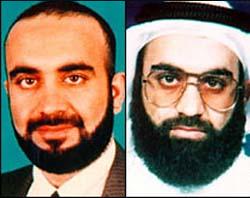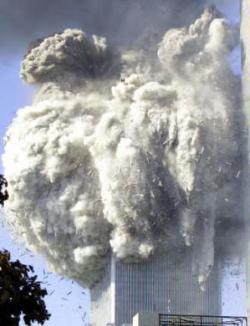Khalid Shaikh Mohammed Said To Have Plotted 9/11 Attacks
Col. Rodolfo Mendoza, the former intelligence chief of the
Philippine National Police, watched in horror, as we all did, when
two airliners destroyed the World Trade Center Sept. 11, 2001.
"They've done it," Mendoza said to himself.
 "They" were a small group of Islamic extremists
who hated America and Jews, a group that had tried to blow up New
York's World Trade Center in 1993 and two years later had come up
with the idea of using hijacked airplanes as guided bombs.
"They" were a small group of Islamic extremists
who hated America and Jews, a group that had tried to blow up New
York's World Trade Center in 1993 and two years later had come up
with the idea of using hijacked airplanes as guided bombs.
Mendoza knew because Philippine police had foiled a plan by the
terrorists, called "Project Bojinka," to blow up 12 American-bound
airliners from Manila's Nino Aquoy International Airport (right)
over the Pacific. They caught one of the plotters, a hapless
Pakistani pilot and bomb maker named Abdul Hakim Murad, trying to
sneak into a Manila apartment to retrieve a Toshiba laptop computer
loaded with incriminating plans.
All but one of the terrorists behind that series of foiled or
abandoned plans are in prison now. But their leader, a shadowy
Pakistani named Khalid Shaikh Mohammed, eluded capture, first in
Manila and later in the Persian Gulf nation of Qatar. He made his
way to Afghanistan, carrying with him the idea of turning jetliners
into smart bombs.
Osama bin Laden and his top aides, Egyptian doctor Ayman al
Zawahiri and former Egyptian policeman Mohammed Atef, bin Laden's
military chief, liked Mohammed's idea.
The End Of The Line
 Khalid Shaikh Mohammed (right) was captured by
Pakistani and American intelligence operatives over the weekend.
He's now being interrogated in an undisclosed foreign country.
Khalid Shaikh Mohammed (right) was captured by
Pakistani and American intelligence operatives over the weekend.
He's now being interrogated in an undisclosed foreign country.
The top priority during the questioning will be to find out
whether other attacks are in the works, information vital to
stopping the terrorists, American counterterrorism officials
said.
But such information is just what Mohammed will probably to try
to keep secret. Still, terrorists who learn of Mohammed's capture
may alter their plans, abandon safe houses or make hurried
telephone calls - actions that could expose them to detection.
The only Al Qaeda capture that even comes close to this
magnitude was that of Abu Zubaydah last March. Zubaydah more than
once provided information that sent American security officials
scurrying to provide warnings to cities and sectors of the economy,
knowing all the while that he could be lying.
But Zubaydah has provided some information that was later
verified through other sources, officials said. That included
intelligence that led to the detention of Jose Padilla, the
American federal officials say was plotting to use a radiological
weapon - a "dirty bomb" somewhere in the USA.
American Leaders "Elated" By Capture
U.S. officials were elated by Mohammed's capture. "This is equal
to the liberation of Paris in the second World War," said GOP Rep.
Porter Goss of Florida, chairman of the House Intelligence
Committee, on ABC's "This Week."
"This is a giant step backward for the Al Qaeda," Republican
Sen. Pat Roberts of Kansas, chairman of the Senate Intelligence
Committee, told "Fox News Sunday." "Now their operations commander
is simply out of operations."
Officials aren't saying anything about Mohammed's detention.
Previous high-level Al Qaeda captives have not been brought to
America; they would have rights not afforded on foreign soil, U.S.
officials say. Where they are, however, has not been disclosed.
As his interrogation moves away from the immediate, Mohammed can
provide counterterrorism officials with a deeper understanding of
Al Qaeda and its history.
Officials believe he can detail how Sept. 11 was put together,
answering long-standing questions about the plot's origins: Who
chose the World Trade Center and Pentagon as targets? Who picked
Sept. 11 as the date?

How Mohammed Fit Into Al-Qaeda
American officials say Mohammed, who was born in Kuwait and has
both Pakistani citizenship and ancestry, planned and coordinated
key aspects of the Sept. 11 operation.
His information can be cross-checked with Ramzi Binalshibh's,
his former aide who was captured in September. Binalshibh was a
part of the cell that included Mohamed Atta, chief among the Sept.
11 hijackers.
Abu Zubaydah, the highest-ranking al-Qaida leader now in
custody, has told American officials Mohammed was the brains behind
the Sept. 11 attacks on the World Trade Center and the Pentagon, as
well as the first Trade Center bombing in 1993 and the failed 1995
"Bojinka" plot in Manila.

At least one scrap of evidence suggests that Zubaydah may be
telling the truth about Khalid Shaikh Mohammed. Intelligence
officials said Mohamed Atta (right), the commander of the suicide
hijackers, called Mohammed on Sept. 10.
The conversation was monitored by the National Security Agency
but translated from Arabic only after the attacks that killed more
than 3,000 persons. Intelligence officials believe that Mohammed,
using coded language, gave Atta final approval for the four teams
of hijackers to proceed.
"Bin Laden is unquestionably the leader, the symbol and the
recruiting poster," the official said. "But it's looking more and
more like Khalid actually makes things happen."
Roland Jacquard, a French terrorism expert and U.N. Security
Council consultant, said, "He is probably the only man who knows
all the pieces of the puzzle."
Where Atta and the other Sept 11 hijackers were stealthy,
Mohammed was flamboyant. Atta, his main foot soldier, was thin and
disciplined; Mohammed was neither. The hijackers slipped in and out
of Econo Lodges; Mohammed preferred five-star hotels.
Colonel Mendoza knew Khalid Shaikh Mohammed as Abdul Majid, a
Saudi businessman who lived in the top floor of Manila's Josefa
Apartments with Ramzi Yousef, who was later convicted in the first
World Trade Center blast, which killed six and injured around
1,000. Some officials say Yousef is Mohammed's nephew; others
aren't sure.
Mohammed used other names: Salim Ali, Ashrai Refaat, Nabith
Renin, Khalid Abdul Waddod and Fahd Bin Abdullah Bin Khalid, maybe
a dozen pseudonyms in all. He isn't a Saudi or Qatari businessman,
as he claimed in Manila, but a Kuwaiti-born and U.S.-educated
Pakistani with a vast network of contacts and covers.
"He behaves like he's an intelligence officer," Mendoza said.
"He appears and disappears. He has safe houses. He is very, very
clever."
 ANN's Daily Aero-Term (04.20.24): Light Gun
ANN's Daily Aero-Term (04.20.24): Light Gun Aero-News: Quote of the Day (04.20.24)
Aero-News: Quote of the Day (04.20.24) ANN's Daily Aero-Linx (04.21.24)
ANN's Daily Aero-Linx (04.21.24) Aero-News: Quote of the Day (04.21.24)
Aero-News: Quote of the Day (04.21.24) ANN's Daily Aero-Term (04.21.24): Aircraft Conflict
ANN's Daily Aero-Term (04.21.24): Aircraft Conflict






